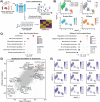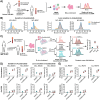This is a preprint.
Integrating Single-Cell Biophysical and Transcriptomic Features to Resolve Functional Heterogeneity in Mantle Cell Lymphoma
- PMID: 40475412
- PMCID: PMC12139831
- DOI: 10.1101/2025.05.20.655210
Integrating Single-Cell Biophysical and Transcriptomic Features to Resolve Functional Heterogeneity in Mantle Cell Lymphoma
Abstract
Intra-tumor heterogeneity impacts disease progression and therapeutic resistance but remains poorly characterized by conventional histologic, immunophenotypic, and molecular approaches. Single-cell biophysical properties distinguish functional phenotypes complementary to these approaches, providing additional insight into cellular diversity. Here we link both buoyant mass and stiffness to gene expression to identify clinically relevant phenotypes within primary mantle cell lymphoma (MCL) cells, employing MCL as a model of biological and clinical diversity in human cancer. Linked measurements reveal that buoyant mass and stiffness characterize B-cell development states from naïve to plasma cell and correlate with expression of oncogenic B-cell receptor signaling genes such as BLK and CD79A. Additionally, changes in cell buoyant mass within primary patient specimens ex vivo correlate with sensitivity to Bruton's Tyrosine Kinase inhibitors in vivo in MCL and chronic lymphocytic leukemia, another B-cell malignancy. These findings highlight the value of biophysical properties as biomarkers of response in pursuit of future precision therapeutic strategies.
Conflict of interest statement
M.A.M received research funding from Roche/Genentech and Kite/Gilead, and is an advisory board member of CancerModels.org. S.R.M. is a founder of Travera and Affinity Biosensors. D.M.W. owns equity in Travera, Merck and Co., Bantam, and Ajax, received consulting fees from Astra Zeneca, Secura, Novartis, and Roche/Genentech, and received research support from Daiichi Sankyo, Astra Zeneca, Verastem, Abbvie, Novartis, Abcura, and Surface Oncology. C.E.R. has received honoraria from Research to Practice, Curio Science, and AstraZeneca, and has received institutional research funding from Genentech. A.I.K. has received honoraria from MJH Life Sciences and institutional research funding from AstraZeneca. M.J.A. is a co-founder of, owns equity in, and receives consulting fees from SeQure Dx and receives consulting fees from Chroma Medicine, unrelated to this work. T.P.M., M.A.M., S.R.M., and D.M.W. have filed a patent related to this work. All other authors declare they have no competing interests.
Figures





References
-
- Guck J., Schinkinger S., Lincoln B., Wottawah F., Ebert S., Romeyke M., Lenz D., Erickson H. M., Ananthakrishnan R., Mitchell D., Käs J., Ulvick S., Bilby C., Optical Deformability as an Inherent Cell Marker for Testing Malignant Transformation and Metastatic Competence. Biophys. J. 88, 3689–3698 (2005). - PMC - PubMed
-
- Otto O., Rosendahl P., Mietke A., Golfier S., Herold C., Klaue D., Girardo S., Pagliara S., Ekpenyong A., Jacobi A., Wobus M., Töpfner N., Keyser U. F., Mansfeld J., Fischer-Friedrich E., Guck J., Real-time deformability cytometry: on-the-fly cell mechanical phenotyping. Nat. Methods 12, 199–202, 4 p following 202 (2015). - PubMed
Publication types
Grants and funding
LinkOut - more resources
Full Text Sources
Miscellaneous
